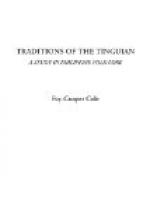[234] Reduplicated form of bitowen—many stars.
[235] See p. 15, note 2.
[236] The spirits’ name for mortals.
[237] The moon.
[238] A sort of enclosed seat in which babies are suspended from the house rafters.
[239] See p. 13, note 2.
[240] See p. 13.
[241] Aponitolau.
[242] The name means “sparks of fire.”
[243] See p. 13, note 2.
[244] See p. 56, note 6.
[245] Similiar incidents, in which women give birth to snakes or animals, occur in Borneo. See Evans, Journal Royal Anthro. Inst., Vol. XLIII, 1913, pp. 432 ff.
[246] See p.17, note 3.
[247] Aponitolau.
[248] Sugar cane rum.
[249] See p. 41, note 2.
[250] See p. 27.
[251] See p. 17, note 3.
[252] See p. 73, note 3.
[253] Lesser spirits.
[254] See p. 54, note 2.
[255] See p. 10, note 1.
[256] See p. 10, note 2.
[257] The cloth used in dancing. See p. 11.
[258] See p. 63, note 1.
[259] See p. 12.
[260] Another name for Kanag.
[261] A raft. See p. 24, note 1.
[262] The Tinguian believe that the rivers and waters finally empty over the edge of the world at a place known as Nagbotobotan.
[263] See p. 18, note 1.
[264] See p. 13, note 2.
[265] See p. 41, note 2.
[266] A jar.
[267] Mountain rice.
[268] The omen bird.
[269] See p. 19, note 1.
[270] See p. 10, note 1.
[271] The storyteller here paused to explain that Kadalayapan was somewhere in the air, and that Kanag was going down to the earth for fruit. See p. 7.
[272] A band of leaves worn about the head.
[273] See p. 18, note 2.
[274] See p. 30, note 3.
[275] A place of great trees, many herbs, and continued dampness.
[276] See p. 13.
[277] Negrito. It was Gamayawan disguised.
[278] See p. 23.
[279] See p. 17.
[280] A powerful spirit.
[281] See p. 30, note 3.
[282] A sort of tuning fork made of bamboo.
[283] See p. 96, note 3.
[284] The word is probably used in the Igorot sense as “celebration.” In the Tinguian dialects kanyau means “taboo.”
[285] See p. 17, note 1.
[286] See p. 18, note 1.
[287] See p. 63.
[288] See p. 24, note 1.
[289] This story does not belong to the cycle proper.
[290] See p. 34, note 2.
[291] See p. 14.
[292] The Tinguian always refer to the Igorot as alzado.
[293] Head man.
[294] This story does not belong to the cycle.
[295] See p. 54, note 2.
[296] See p. 14.




